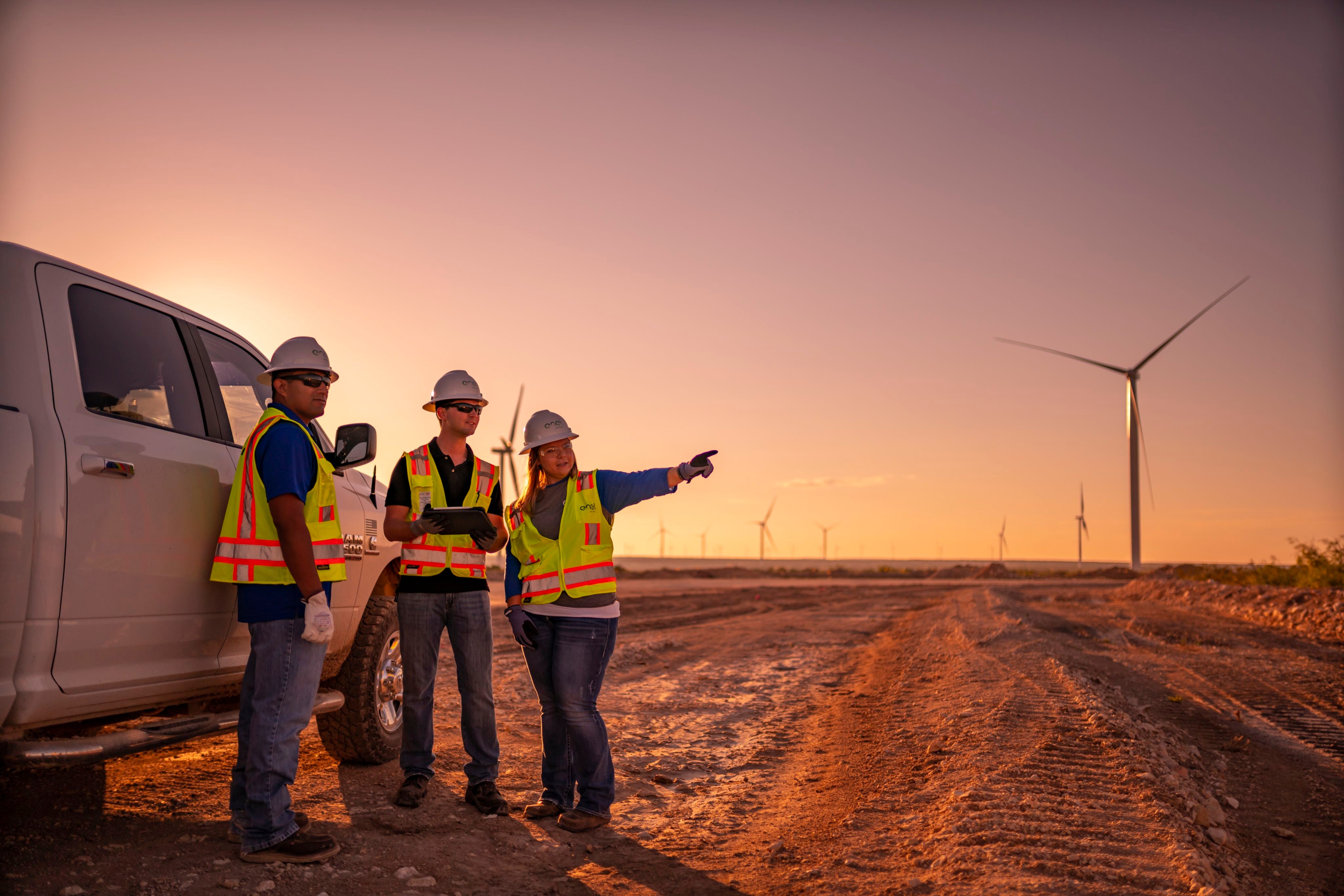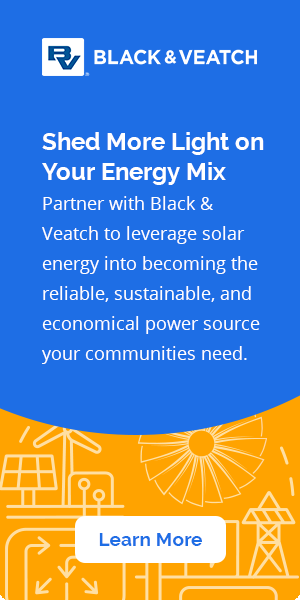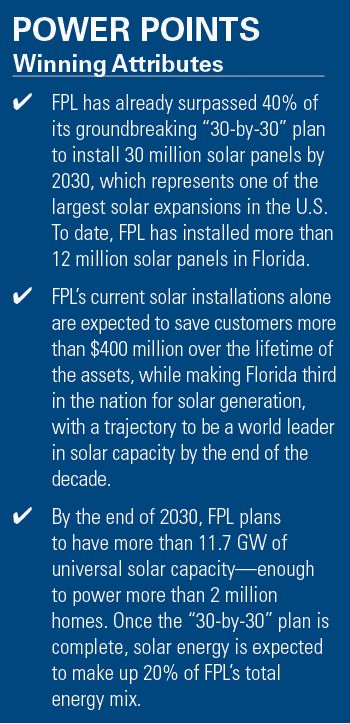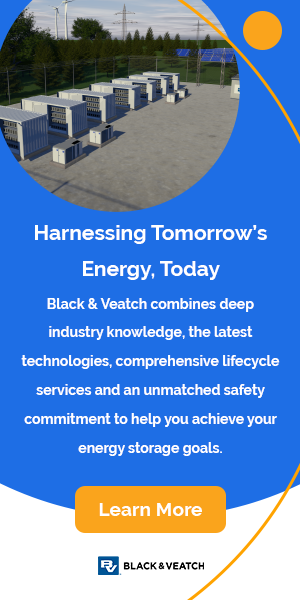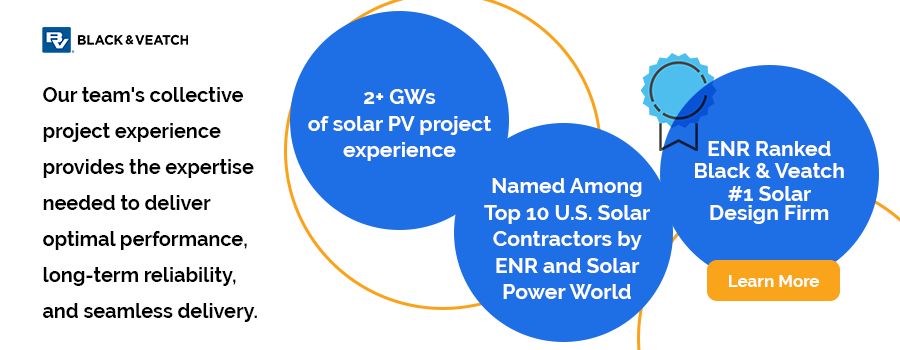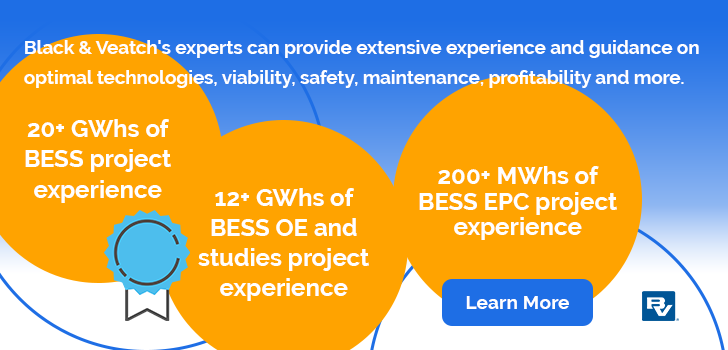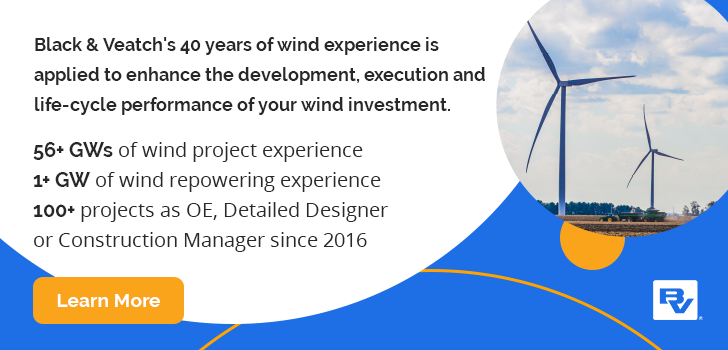Black & Veatch Congratulates POWER Magazine’s Top Renewable Power Plants
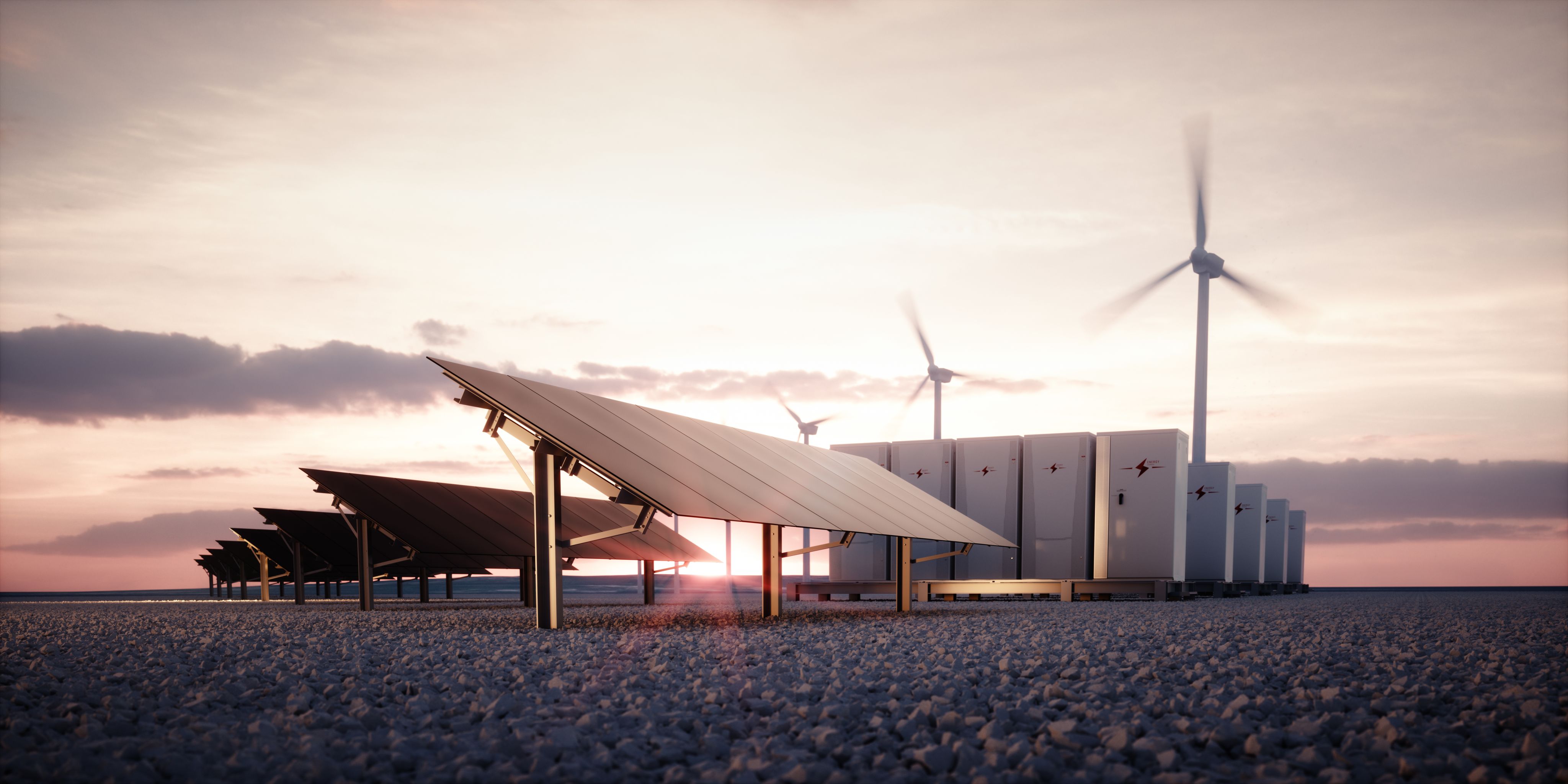
Sun Shines on FPL’s Solar Program
Power generation companies are continually looking for ways to make their operations more cost-effective, in part by seeking out investments that will bolster the bottom line while maintaining their commitment to provide customers with reliable electricity. Many of those utilities want to take advantage of renewable energy resources, making cleaner energy a larger piece of their generation portfolio.
Florida Power & Light (FPL), a subsidiary of NextEra Energy Inc. that provides power for more than 11 million Floridians, has taken a lead role in providing solar power across much of the state, building dozens of utility-scale arrays, and working with businesses and homeowners in support of rooftop solar systems. FPL in 2019 announced its “30-by-30” plan, a program in which the utility pledged to install 30 million solar panels by 2030. FPL in June of this year said the program was more than 40% complete after just two years, with 42 solar energy centers in operation, including the Discovery Solar Energy Center (shown above) at Kennedy Space Center.
“The cost of each solar energy center can vary based on a number of factors, but those costs continue to come down over time,” Matt Valle, vice president of development at FPL, told POWER. “As a general estimate, each solar energy center represents an investment of [about] $90 million.”
Many of those solar energy centers support FPL SolarTogether, the company’s community solar initiative. “Each of our solar energy centers feeds the FPL grid, benefiting all FPL customers,” said Valle. “Twenty of our 42 operating solar energy centers are part of the FPL SolarTogether program—the largest community solar program in the country. It’s a subscription-based program that offers participants the option to meet up to 100% of their energy needs from renewables, giving everyone the opportunity to participate in solar, no matter where they live and whether they rent or own their home or business. The program launched 18 months ago and is now fully subscribed, demonstrating the desire for customers of all sizes to have renewable energy options.”
Valle told POWER that “16 new FPL solar energy centers began operations across Florida in 2020, and nine more FPL solar energy centers have started operations in 2021. As of [mid-July], eight more FPL solar energy centers are under construction, and our construction timeframes are generally six to 10 months.”
That commitment to solar energy is among the reasons POWER has given FPL’s solar energy centers a Top Plant award in the renewable energy category. “The most important thing to remember is that FPL’s solar energy centers are built cost-effectively. In addition to reducing emissions, each solar energy center is projected to save our customers money over time,” said Valle.
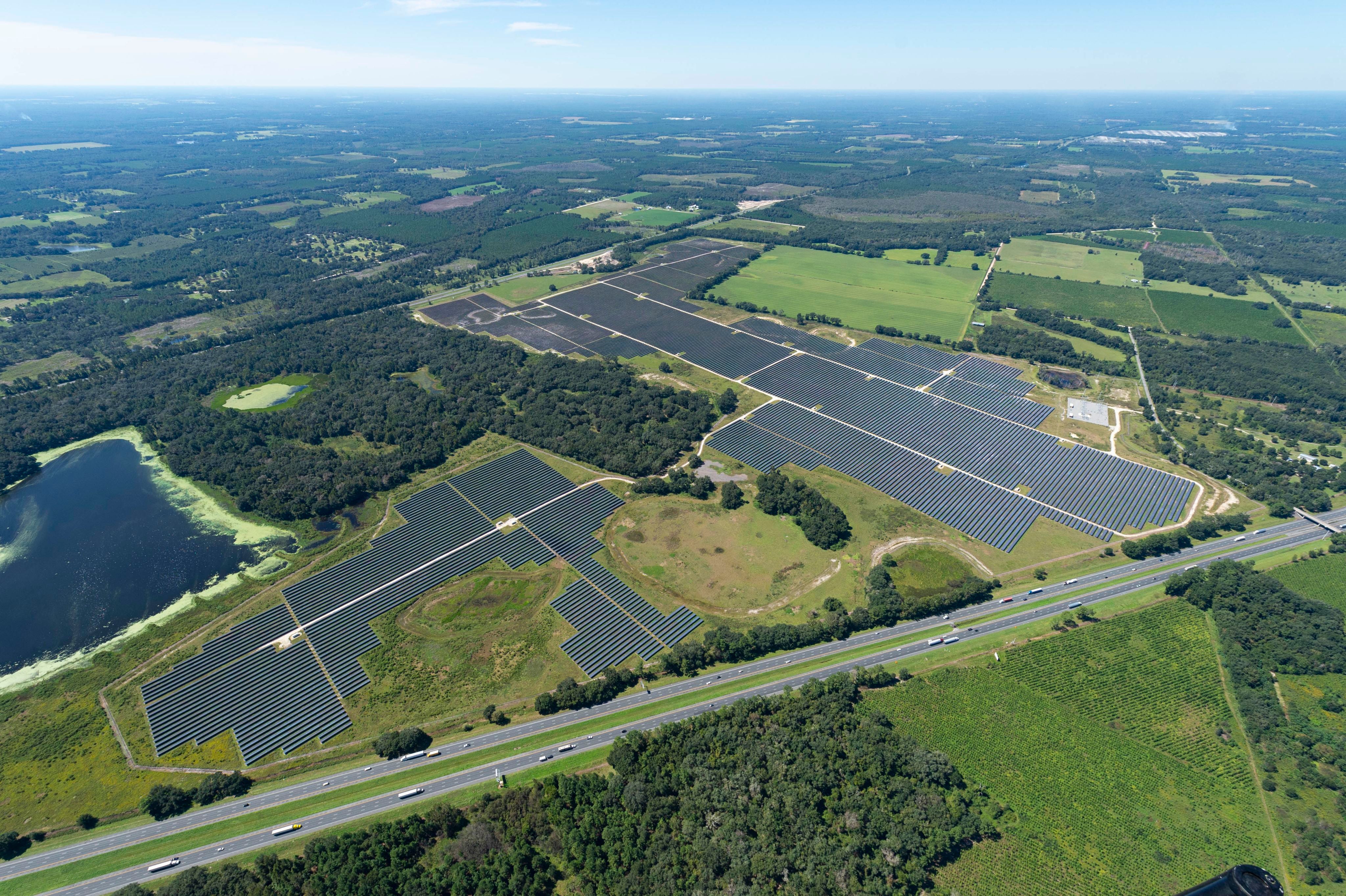
Plans for 11.7 GW of Solar Generation Capacity
FPL has said it plans to have 11.7 GW of universal solar power generation capacity online by the end of 2030. “Nobody in the country is building more solar than FPL,” Eric Silagy, president and CEO of FPL, said in a June news release. “We’re dedicated to providing our customers with clean, affordable and reliable energy, while keeping bills among the nation’s lowest—and our rapid solar expansion helps us consistently deliver on this promise. In total, FPL customers are expected to save approximately $421 million from the cost-effective solar investments the company has made to this point.”
Valle said the 42 operating solar energy centers represent 3,015 MW of generation capacity. “Combined, our solar fleet consists of over 12 million photovoltaic [PV] solar panels and can generate enough energy to power more than 600,000 homes annually,” Valle said. “Once our ‘30-by-30’ plan is complete, solar energy is expected to make up 20% of FPL’s total energy mix.”
FPL’s solar program includes powering Babcock Ranch, a community in Charlotte County, considered the first solar-powered town in the U.S. The utility has two solar energy centers onsite—FPL Babcock Ranch Solar Energy Center and FPL Babcock Preserve Solar Energy Center. Net power production from the two installations exceeds the total amount of power consumed by the town.
“Every FPL solar energy center stands out for its ability to create jobs, increase local tax revenue, and improve the natural environment,” said Valle, pointing to Babcock Ranch and other solar farms.
1. Florida Power & Light’s (FPL’s) Sunshine Gateway Solar Energy Center, located in Columbia County, Florida, is visible from both Interstate 75 and Interstate 10, providing a stunning visual for travelers on those busy highways. Courtesy: FPL
“The FPL Interstate Solar Energy Center and FPL Sunshine Gateway Solar Energy Center, both of which were completed in 2019, are unique for their highly visible locations,” Valle told POWER. “The FPL Interstate Solar Energy Center in St. Lucie County can be seen from both I-95 and Florida’s Turnpike. According to the Florida Dept. of Transportation, an estimated 3 million cars drove by the site [in the past month]. The FPL Sunshine Gateway Solar Energy Center [Figure 1] is located in Columbia County where I-10 and I-75 cross. Travelers on both highways can see the solar energy center, and the Florida Dept. of Transportation’s I-10 Westbound rest area offers a sweeping view of thousands of the panels.”
Valle touted the installations’ environmental benefits. “The FPL Sweetbay Solar Energy Center is an excellent example of how FPL solar projects not only provide clean, renewable energy for Floridians but also help to restore and preserve our natural resources,” he said. “As part of the project, FPL preserved 80 acres of wetlands and an additional 45 acres of upland buffer around each wetland, restored the hydrology of the wetlands by installing six water control structures, and, through the Martin County Preserve Area Management Plan, preserved four acres of upland habitat, and eradicated and removed 90 tons of invasive plant species. Additionally, through FPL’s solar stewardship program, several waterfowl nest boxes and wildlife perches were installed along with approximately 40,000 native trees, shrubs, and wetland plants to increase biodiversity within the on-site wetlands and buffers.”
Key Collaboration
DeSoto County has been at the forefront of FPL’s solar efforts for more than a decade, a collaboration that continues. “In May, FPL completed its fifth solar energy center in DeSoto County, the FPL Rodeo Solar Energy Center. FPL’s partnership with DeSoto is unique, because the county has been the innovation hub for FPL’s clean energy investments since the construction of our first large-scale solar energy center—the FPL DeSoto Next Generation Solar Energy Center. At 25 MW, it was the largest in the nation when it was commissioned by President Barack Obama in 2009,” Valle said.
“Then, in 2016, FPL started to build solar more cost-effectively with three 74.5-MW solar energy centers, including the FPL Citrus Solar Energy Center in DeSoto. Each of those three centers constructed in 2016 was three times the size of the first and cost less to build. Then, in 2018, DeSoto made history again when FPL announced the first-of-its-kind large-scale application of ‘DC-coupled’ batteries at a solar plant in the nation, also at the FPL Citrus Solar Energy Center,” he said.
Valle said FPL is proud of the utility’s 40th solar energy center, the FPL Discovery Solar Energy Center at the Kennedy Space Center. The center—named after the Discovery space shuttle—features about 250,000 solar panels, all feeding directly into FPL’s electricity grid to serve Kennedy Space Center and other areas. “FPL worked with NASA to select a plot of land that could be used for solar development,” Valle said. “Prior to the project installation, the site contained old orange groves that had become dormant and was overgrown with invasive plant species.”
Janet Petro, acting director of the Kennedy Space Center, emphasized the importance of the solar energy center during a June ceremony to mark its commissioning. “Kennedy Space Center is our nation’s gateway to the universe, but our responsibility to future generations starts right here at home. For this reason, leasing the land for the Discovery Solar Energy Center to FPL is a win-win,” said Petro. “Now, previously underutilized NASA land is generating clean, zero-emissions energy for the space center and beyond.”
FPL’s program is another example of utilization, with the use of a resource the Sunshine State has in abundance. “We have always and will always be committed to working closely with the local community as we bring cost-effective solar energy to Florida,” Valle said. “FPL solar energy centers are good neighbors that benefit the local economy and the natural environment. They are virtually silent, remotely monitored, and peacefully generate zero-emissions energy, jobs during construction, and tax revenue. Our solar energy centers operate without water or fuel, placing little or no demand on public services. We’re also excited about our investment in solar energy because of the enormous positive impact it has on Florida’s natural environment. In 2020 alone, our solar energy centers avoided CO 2 emissions equivalent to removing over 423,000 cars from the road. In short, our solar energy centers have overwhelmingly positive benefits on the communities with which we partner.”
Winds of Change Revitalize West Texas
A major wind farm sited on 200 square miles across two Texas counties is part of that state’s commitment to renewable energy, part of an energy transformation in a region once known for its oil boomtowns.
The plains of West Texas for years have been featured as the backdrop for numerous Hollywood movies, whether the plot centered around the region’s oil wells, its cattle ranches, high school football or dusty baseball fields, all with sweeping vistas stretching to the horizon. Those visuals remain, but in recent years the area has also become known for its renewable energy resources, particularly the soaring blades of wind turbines that have made Texas the nation’s top state when it comes to producing wind power.
The region’s wind farms are creating their own stories, continuing to cement Texas’ legacy as a global energy giant. The High Lonesome Wind Farm, a project near the small town of McCamey, population about 2,000, in an area that state lawmakers call the “Wind Energy Capital of Texas,” provides a model for Texas’ renewable energy renaissance. The wind farm has brought the rebirth of an oil boomtown, uplifting a community by providing not only energy but also supporting investments that benefit local residents, farmers, and ranchers.
High Lonesome, located across 200 square miles in Upton and Crockett counties in Texas—about 290 miles northwest of San Antonio, and 120 miles west of San Angelo—is a 500-MW installation, one of the largest operational wind farms in Enel Green Power’s portfolio. The project is known for its positive impact on the rural area around the wind farm, and also for its innovative corporate power purchase agreement (PPA) that supports Danone North America’s commitments to sustainable business practices. High Lonesome is a model for other successful wind power and renewable energy projects, and is being honored with a POWER Top Plant award in the renewable energy category.
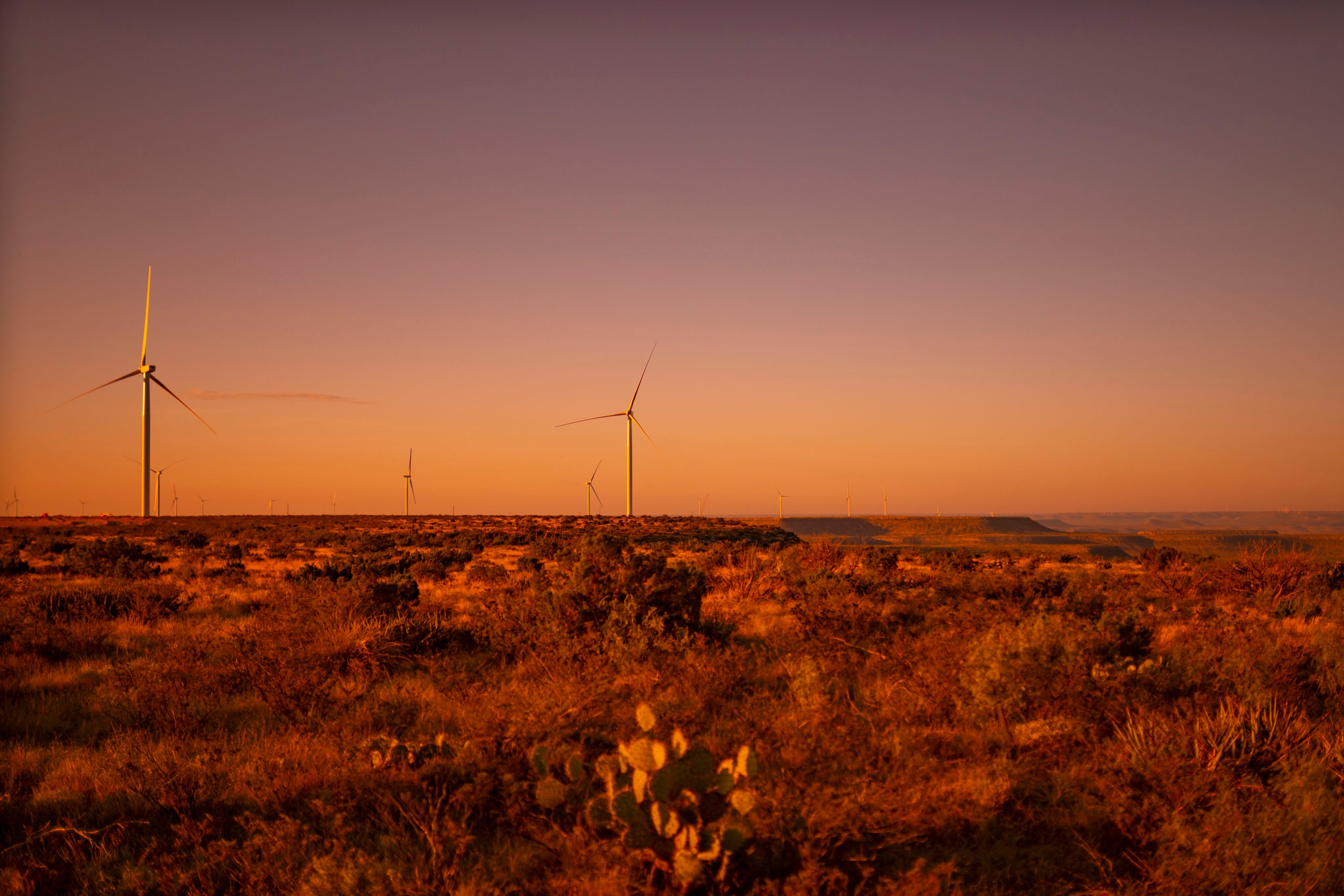
Two-Part Project
Construction of the High Lonesome wind farm began in January 2019; the first 450-MW portion of the project came online in December 2019, with the remaining 50-MW portion starting up in May 2020. The 50-MW expansion is supported by a 12-year PPA with food and beverage company Danone North America, one of the project’s innovative financial strategies.
“High Lonesome, including its 50-MW expansion, our PPA with Danone, and construction of an additional 57-MW battery storage facility, underscores our commitment to development in Texas and decarbonizing the local grid,” said Imanol San Martin, head of Wind Operations and Maintenance at Enel Green Power in the U.S. and Canada.
The final 50-MW portion of High Lonesome came online in 2020, about the same time Enel Green Power connected two wind farms in Alberta, Canada, to the grid.
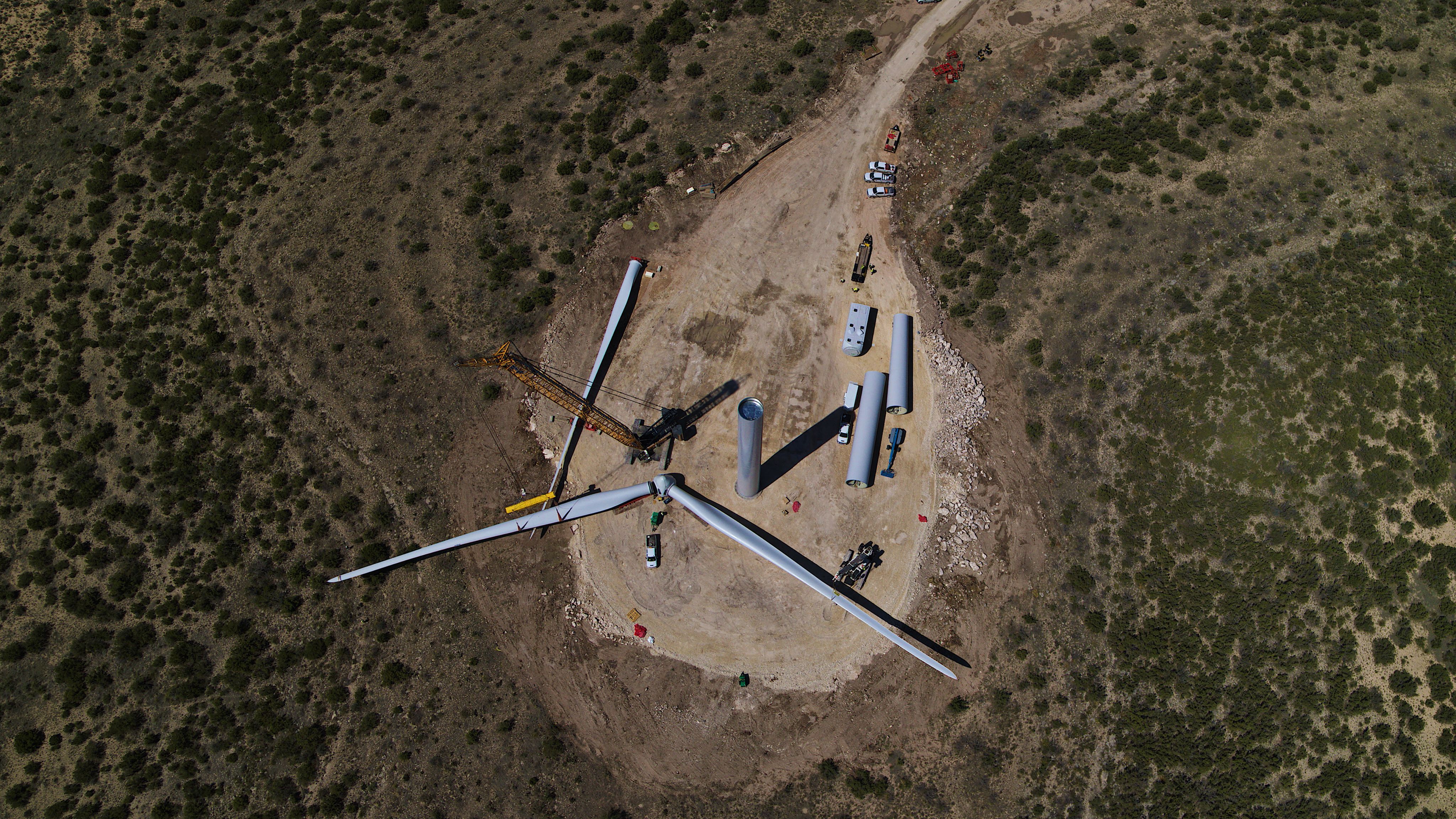
1. The various parts of one of High Lonesome’s 164 wind turbines are visible in this aerial shot, photographed by a drone above the wind farm. High Lonesome uses a mix of wind turbines, models from Acciona and GE Renewable Energy. Courtesy: Enel Green Power
1. The various parts of one of High Lonesome’s 164 wind turbines are visible in this aerial shot, photographed by a drone above the wind farm. High Lonesome uses a mix of wind turbines, models from Acciona and GE Renewable Energy. Courtesy: Enel Green Power
Battery Energy Storage
Enel Green Power North America in May of this year announced it has started construction on several new renewable energy projects in the U.S., including a battery energy storage system at High Lonesome, along with a similar storage system at its Roadrunner solar farm in Texas.
San Martin told POWER, “Construction is beginning this summer on a 57-MW [power rated DC] battery storage facility co-located with High Lonesome. This facility will store energy generated by the wind turbines and discharge to capture additional value streams and support grid reliability.”
Other projects, including elsewhere in Texas along with Illinois and Oklahoma, mean Enel this summer has been working on more than 2.3 GW of new generation capacity, along with more than 600 MW of battery storage capacity.
“We are proud to support rural communities across the Lone Star State by investing in new projects that create jobs and revenue for schools,” said San Martin. “Furthermore, by constructing eight utility-scale batteries this year, we are deploying state-of-the-art storage technology to support a more resilient power grid.”
High Lonesome has 164 wind turbines (Figure 1). A specification sheet for the project from The Wind Power, a group providing market intelligence on wind energy, lists the majority of turbines as Acciona AW-3465/132 and Acciona AW-3000/132 models; Acciona is a renewable energy developer and global wind turbine manufacturer headquartered in Spain. Other turbines used in the project are GE Renewable Energy 2.3-116 models.
“Investment in the construction of the 500-MW plant amounted to around $720 million,” said San Martin. Enel on its website notes that lease payments for the project are expected to top $90 million, with local tax revenue of more than $75 million, over the lifetime of the project.
The project has focused on sustainability. During construction, field offices used water dispensers and reusable canteens to reduce single-use plastic water bottle use. Paper, cardboard, aluminum, ink cartridges, oil, and grease were recycled responsibly, according to Enel. Solar-powered lights were used during construction, and a solar photovoltaic system was designed for use by the permanent operations building.
“The construction of High Lonesome was completed in alignment with Enel Green Power’s Sustainable Construction Site model, which is a framework aimed at minimizing the impact of plant construction on the environment, waste, water and people,” said San Martin.
Enel noted that drones were used for road surveys and for monitoring the progress of construction. The company said the “ARC GIS application was utilized to quickly transmit information between workers,” and a “360-degree camera was utilized to record construction activities.” It said iPads were used by workers in the field to access drawings and other construction-related documents, in part to reduce the amount of paper waste.
Innovative PPA with Danone North America
The past several years have seen a surge in the number of businesses transitioning their electricity supply to 100% renewable energy through corporate PPAs. At High Lonesome, the traditional virtual power purchase agreement is taken a step further with food and beverage company Danone North America. In 2019, Enel Green Power and Danone North America designed a customized PPA for the physical delivery of the renewable electricity associated with 20.6 MW of the wind farm, enabling the food and beverage company to sustainably power its production facilities in Texas.
The agreement between Enel and Danone North America will provide enough electricity to produce the equivalent of almost 800 million cups of yogurt, and more than 80 million gallons of milk each year, and support the food and beverage company’s commitment to securing 100% of its purchased electricity from renewable sources by 2030.
“Transitioning our Texas plants to a physical delivery PPA was especially important to us as we strive to change the game when it comes to fostering positive solutions for the planet. We strongly believe that the health of our planet and our people are inextricably linked so, as we work to further our mission of bringing health through food to as many people as possible, we’re delighted to be working with Enel Green Power to expand its High Lonesome wind farm and grow the renewable electricity infrastructure here in the U.S.,” said Marc De Schutter, head of Procurement for Danone North America.
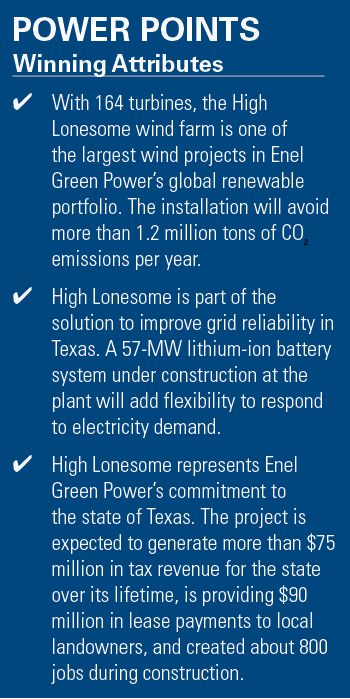
Community Support
Supporting the local community has been a major part of the project, bringing important resources to the McCamey area as part of its financial commitment to the region.
“The money that Enel gave to us will provide us several pieces of much-needed equipment. It will definitely help the wellness center to continue to be able to provide the services we do for the community,” said Lucy Johnson, Wellness Center Director for the McCamey Hospital District, in a testimonial on the Enel Green Power website.
Enel has plans to bring more renewable energy projects online in the next decade, adding to an impressive portfolio worldwide. The company in November 2020 announced it expects to triple its global capacity from renewable sources, reaching around 145 GW of installed capacity by 2030. Currently, Enel has about 50 GW of wind, solar, geothermal, and hydropower plants across the globe.
And North America will continue to be an important area for the Rome, Italy-headquartered company. “As part of its three-year strategic plan announced in November 2020, Enel Green Power is planning to bring an additional 3 GW of renewable capacity online in North America by 2023,” said San Martin. “Wind will make up a substantial portion of this growth.”
